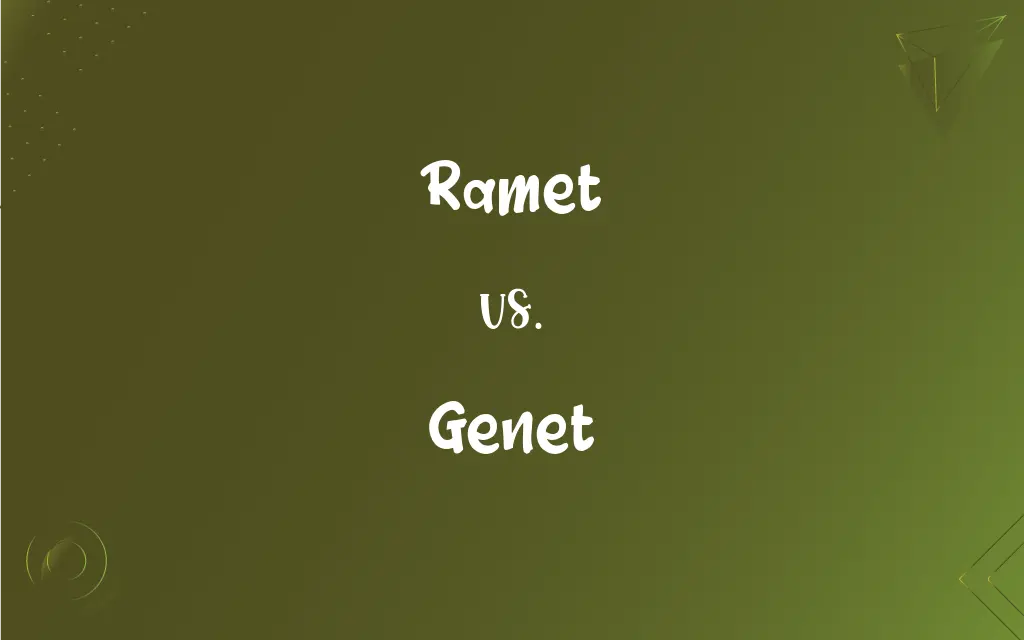Ramet vs. Genet: What's the Difference?
By Harlon Moss & Aimie Carlson || Updated on May 21, 2024
A ramet is an individual member of a clone that can live independently, while a genet is the entire genetic individual made up of one or more ramets. Ramets are clones, whereas genets are the collective organism.

Key Differences
A ramet is an individual organism that is part of a larger clonal colony, capable of living independently. For instance, each tree in a grove of aspen trees that are genetically identical and connected by roots is a ramet. In contrast, a genet refers to the entire genetic entity that consists of one or multiple ramets. In the same aspen grove, the genet would be the entire interconnected system of trees sharing the same genetic material.
Ramets can exist independently or remain connected to the parent organism, functioning as autonomous units. These individual units may be physically separated but genetically identical. Genets encompass all ramets derived from a single zygote, forming a comprehensive genetic entity. Even when ramets separate physically, they still represent a single genet.
Ramets exhibit behaviors and growth patterns influenced by their immediate environment, showing adaptability and individual responses. Meanwhile, genets display overall genetic stability and continuity across all ramets, ensuring the persistence of genetic traits.
The distinction between ramets and genets is essential in understanding plant ecology and evolutionary biology, as it affects the study of reproduction, survival strategies, and genetic diversity.
Comparison Chart
Definition
Individual clone member
Entire genetic individual
ADVERTISEMENT
Independence
Can live independently
Made up of multiple ramets
Origin
Derived from a genet
Derived from a single zygote
Genetic Material
Genetically identical to genet
Collective genetic material
Ecological Role
Functions autonomously
Represents the whole clonal colony
Ramet and Genet Definitions
Ramet
Can exist independently.
The ramet survived after being cut off from the parent plant.
ADVERTISEMENT
Genet
The entire genetic individual in clonal species.
The aspen grove is one large genet.
Ramet
A member of a clonal colony.
Each strawberry plant that spreads through runners is a ramet.
Genet
Originates from a single zygote.
This large genet started from one seed.
Ramet
Genetically identical to other ramets.
All ramets in this patch share the same genetic makeup.
Genet
Comprises multiple ramets.
Each tree in this genet is connected underground.
Ramet
Derived from the genet.
The new shoot is a ramet growing from the original genet.
Genet
Represents genetic continuity.
Despite the distance, these ramets are part of the same genet.
Ramet
Often found in plant species.
Many grasses produce ramets to expand their territory.
Genet
Can cover large areas.
The genet of this coral reef spans several miles.
Ramet
A physiologically distinct organism that is part of a group of genetically identical individuals derived from one progenitor, as a tree in a group of trees that have all sprouted from a single parent plant.
Genet
Any of several carnivorous mammals of the genus Genetta of Africa, Europe, and the Middle East, having grayish or yellowish fur with dark spots and a long ringed tail.
Ramet
(botany) A clone (individual member of a genet).
Genet
A group of genetically identical individuals descended from one progenitor, as a group of trees that have all sprouted from the roots of a single parent; a clone.
Genet
See jennet.
Genet
Any of several Old World nocturnal, carnivorous mammals, of the genus Genetta in the family Viverridae, most of which have a spotted coat and a long, ringed tail.
Genet
The fur of this mammal, or any skin dressed in imitation of it.
Genet
(biology) A group of genetically identical individuals (plants, fungi, bacteria etc.) that have grown in a given location, all originating from asexual reproduction of a single ancestor; a group of ramets.
Genet
A small-sized, well-proportioned, Spanish horse; a jennet.
Genet
One of several species of small Carnivora of the genus Genetta, allied to the civets, but having the scent glands less developed, and without a pouch.
Genet
The fur of the common genet (Genetta vulgaris); also, any skin dressed in imitation of this fur.
Genet
A small-sized, well-proportioned, Spanish horse; a jennet.
Genet
French diplomat who in 1793 tried to draw the United States into the war between France and England (1763-1834)
Genet
French writer of novels and dramas for the theater of the absurd (1910-1986)
Genet
Agile Old World viverrine having a spotted coat and long ringed tail
FAQs
What is a genet?
A genet is the entire genetic entity made up of one or more ramets.
Are ramets genetically identical?
Yes, ramets are genetically identical to each other.
Can a ramet live independently?
Yes, a ramet can live independently from the parent organism.
How do ramets benefit a plant species?
Ramets allow a plant to spread and colonize new areas quickly.
What is a ramet?
A ramet is an individual organism that is part of a clonal colony.
Do genets represent genetic diversity?
Genets represent genetic continuity rather than diversity since all ramets are identical.
What connects ramets in a genet?
Ramets in a genet are connected by their shared genetic material and often by physical connections like roots or runners.
How does a genet form?
A genet forms from a single zygote that produces multiple ramets.
What is an example of a plant that forms ramets?
Strawberries form ramets through runners.
What happens if a ramet dies?
The genet can continue to live through its other ramets.
How does studying ramets and genets help in conservation?
Understanding ramets and genets helps in conserving genetic resources and managing clonal populations.
Can ramets survive if separated from the genet?
Yes, ramets can survive and grow independently if separated.
Is a genet more genetically stable than individual ramets?
Yes, a genet provides genetic stability across its ramets, ensuring the persistence of genetic traits.
What role do genets play in ecology?
Genets ensure the persistence of genetic traits and continuity in a population.
Is each tree in an aspen grove a ramet?
Yes, each tree in an aspen grove is a ramet.
Does a genet include physically separated ramets?
Yes, a genet includes all ramets, even if they are physically separated.
Do all ramets in a genet look the same?
Generally, yes, but environmental factors can cause some variation.
Can genets be found in animal species?
Genets are primarily a concept in plant biology, though some similar structures can occur in certain animals like corals.
Can a genet cover a large area?
Yes, genets can span large areas, especially in clonal plant species.
What is a zygote in the context of a genet?
A zygote is the initial cell from which a genet originates.
About Author
Written by
Harlon MossHarlon is a seasoned quality moderator and accomplished content writer for Difference Wiki. An alumnus of the prestigious University of California, he earned his degree in Computer Science. Leveraging his academic background, Harlon brings a meticulous and informed perspective to his work, ensuring content accuracy and excellence.
Co-written by
Aimie CarlsonAimie Carlson, holding a master's degree in English literature, is a fervent English language enthusiast. She lends her writing talents to Difference Wiki, a prominent website that specializes in comparisons, offering readers insightful analyses that both captivate and inform.































































